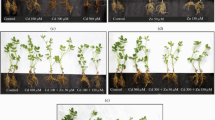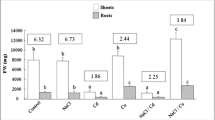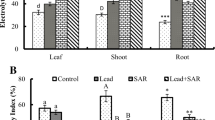Abstract
The present study showed the toxicity caused by heavy metal and its detoxification responses in two desert plants: perennial Peganum harmala and annual Halogeton glomeratus. In pot experiments, 1-month-old seedlings were grown under control and three levels of combined heavy metal stress. Seedling growth as well as heavy metal accumulation, antioxidative enzymes [superoxide dismutase (SOD), catalase (CAT) and ascorbate peroxidase (APX)] activities and the contents of malondialdehyde (MDA), and hydrogen peroxide (H2O2) in leaves was examined after 2 months of heavy metal exposure. Compared with H. glomeratus, growth of P. harmala was more severely inhibited. In leaves, the heavy metal accumulation pattern in both the plants was dose-dependent, being more in H. glomeratus. H. glomeratus exhibited a typical antioxidative defense mechanism, as evidenced by the elevated activities of all the three enzymes tested. P. harmala exhibited a different enzyme response pattern, with a significant reduction in CAT activity, and elevated SOD and APX activities, but significantly elevated APX activity was only at the lowest heavy metal concentration. MDA and H2O2 contents were significantly enhanced in leaves of heavy metal-treated P. harmala, but in H. glomeratus were elevated only at the highest heavy metal treatment. These results indicated that H. glomeratus had a greater capacity than P. harmala to adapt to oxidative stress caused by heavy metal stress, and antioxidative defense in H. glomeratus might play an important role in heavy metal tolerance.







Similar content being viewed by others
Abbreviations
- APX:
-
Ascorbate peroxidase
- CAT:
-
Catalase
- H2O2 :
-
Hydrogen peroxide
- MDA:
-
Malondialdehyde
- SOD:
-
Superoxide dismutase
References
Baker AJM, Brooks RR (1989) Terrestrial higher plants which hyperaccumulate metallic elements-a review of their distribution, ecology and phytochemistry. Biorecovery 1:81–126
Baker AJM, McGrath SP, Sidoli CMD, Reeves RD (1994) The possibility of in situ heavy metal decontamination of polluted soils using crops of metal-accumulating plants. Resour Conserv Recycl 11:41–49. doi:10.1016/0921-3449(94)90077-9
Beauchamp C, Fridovich I (1971) Superoxide dismutase: improved assays and an assay applicable to acrylamide gels. Anal Biochem 44:276–287. doi:10.1016/0003-2697(71)90370-8
Bradford MM (1976) A rapid and sensitive method for the quantification of microgram quantities of protein utilizing the principle of protein-dye binding. Anal Biochem 72:248–254. doi:10.1016/0003-2697(76)90527-3
Conesa HM, Faz Á, Arnaldos R (2006) Heavy metal accumulation and tolerance in plants from mine tailings of the semiarid Cartagena-La Unión mining district (SE Spain). Sci Total Environ 366:1–11. doi:10.1016/j.scitotenv.2005.12.008
Gajewska E, Skłodowska M (2008) Differential biochemical responses of wheat shoots and roots to nickel stress: antioxidative reactions and proline accumulation. Plant Growth Regul 54:179–188. doi:10.1007/s10725-007-9240-9
Gajewska E, Słaba M, Andrzejewska R, Skłodowska M (2006) Nickel-induced inhibition of wheat root growth is related to H2O2 production, but not to lipid peroxidation. Plant Growth Regul 49:95–103. doi:10.1007/s10725-006-0018-2
Garbisu C, Alkorta I (2001) Phytoextraction: a cost-effective plant-based technology for the removal of metals from the environment. Bioresour Technol 77:229–236. doi:10.1016/S0960-8524(00)00108-5
Ghnaya T, Nouairi I, Slama I, Messedi D, Grignon C, Abdelly C, Ghorbel MH (2005) Cadmium effects on growth and mineral nutrition of two halophytes: Sesuvium portulacastrum and Mesembryanthemum crystallinum. J Plant Physiol 162:1133–1140. doi:10.1016/j.jplph.2004.11.011
Gonnelli C, Calardi F, Gabbrielli R (2001) Nickel and copper tolerance and toxicity in three Tuscan populations of Silene paradoxa. Physiol Plant 113:507–514. doi:10.1034/j.1399-3054.2001.113049.x
Gopalachari NC (1963) Changes in the activities of certain oxidizing enzymes during germination and seedling development of Phaseolus mungo and Sorghum vulgare. Indian J Exp Biol 1:98–100
Halliwell B, Gutteridge JMC (1984) Oxygen toxicity, oxygen radicals, transition metals and disease. Biochem J 219:1–14
Hodges DM, DeLong JM, Forney CF, Prange RK (1999) Improving the thiobarbituric acid-reactive-substances assay for estimating lipid peroxidation in plant tissues containing anthocyanin and other interfering compounds. Planta 207:604–611. doi:10.1007/s004250050524
Jouili H, El Ferjani E (2003) Changes in antioxidant and lignifying enzyme activities in sunflower roots (Helianthus annuus L.) stressed with copper excess. C R Biologies 326:639–644. doi:10.1016/S1631-0691(03)00157-4
Jouili H, El Ferjani E (2004) Effect of copper excess on superoxide dismutase, catalase, and peroxidase activities in sunflower seedlings (Helianthus annuus L.). Acta Physiol Plant 26:29–35. doi:10.1007/s11738-004-0041-8
Kartal M, Altun ML, Kurucu S (2003) HPLC method for the analysis of harmol, harmalol, harmine and harmaline in the seeds of Peganum harmala L. J Pharmaceut Biomed 31:263–269. doi:10.1016/S0731-7085(02)00568-X
Khan MA, Gul B, Weber DJ (2001) Seed germination characteristics of Halogeton glomeratus. Can J Bot 79:1189–1194. doi:10.1139/cjb-79-10-1189
Khatun S, Ali MB, Hahn EJ, Paek KY (2008) Copper toxicity in Withania somnifera: growth and antioxidant enzymes responses of in vitro grown plants. Environ Exp Bot 64:279–285. doi:10.1016/j.envexpbot.2008.02.004
Kosugi H, Kikugawa K (1985) Thiobarbituric acid reaction of aldehydes and oxidized lipids in glacial acetic acid. Lipids 20:915–920. doi:10.1007/BF02534777
Kukkola E, Rautio P, Huttunen S (2000) Stress indications in copper- and nickel-exposed Scots pine seedlings. Envrion Exp Bot 43:197–210. doi:10.1016/s0098-8472(99)00057-x
Lei YB, Korpelainen H, Li CY (2007) Physiological and biochemical responses to high Mn concentrations in two contrasting Populus cathayana populations. Chemosphere 68:686–694. doi:10.1016/j.chemosphere.2007.01.066
Liu YB, Zhang TG, Li XR, Wang G (2007) Protective mechanism of desiccation tolerance in Reaumuria soongorica: leaf abscission and sucrose accumulation in the stem. Sci China Ser C 50:15–21. doi:10.1007/s11427-007-0002-8
McClure BC (1998) Policies related to combating desertification in the United States of America. Land Degrad Dev 9:383–392. doi:10.1002/(SICI)1099-145X(199809/10)9:5<383:AID-LDR303>3.0.CO;2-A
Mittler R (2002) Oxidative stress, antioxidants and stress tolerance. Trends Plant Sci 7:405–410. doi:10.1016/S1360-1385(02)02312-9
Mittler R, Vanderauwera S, Gollery M, Van Breusegem F (2004) Reactive oxygen gene network of plants. Trends Plant Sci 9:490–498. doi:10.1016/j.tplants.2004.08.009
Nakano Y, Asada K (1981) Hydrogen peroxide is scavenged by ascorbate-specific peroxidase in spinach chloroplasts. Plant Cell Physiol 22:867–880
Noctor G, Foyer CH (1998) Ascorbate and glutathione: keeping active oxygen under control. Annu Rev Plant Physiol Plant Mol Biol 49:249–279. doi:10.1146/annurev.arplant.49.1.249
Pandey N, Sharma CP (2002) Effect of heavy metals Co2+, Ni2+ and Cd2+ on growth and metabolism of cabbage. Plant Sci 163:753–758. doi:10.1016/S0168-9452(02)00210-8
Pyatt FB, Amos D, Grattan JP, Pyatt AJ, Terrell-Nield CE (2002) Invertebrates of ancient heavy metal spoil and smelting tip sites in southern Jordan: their distribution and use as bioindicators of metalliferous pollution derived from ancient sources. J Arid Environ 52:53–62. doi:10.1006/jare.2002.0982
Schützendübel A, Polle A (2002) Plant responses to abiotic stresses: heavy metal-induced oxidative stress and protection by mycorrhization. J Exp Bot 53:1351–1365. doi:10.1093/jexbot/53.372.1351
Sergiev I, Alexieva V, Karanov E (1997) Effect of spermine, atrazine and combination between them on some endogenous protective systems and stress markers in plants. Compt Rend Acad Bulg Sci 51:121–124
Shah K, Kumar RG, Verma S, Dubey RS (2001) Effect of cadmium on lipid peroxidation, superoxide anion generation and activities of antioxidant enzymes in growing rice seedlings. Plant Sci 161:1135–1144. doi:10.1016/S0168-9452(01)00517-9
Takahashi R, Nishio T, Ichizen N, Takano T (2007) Salt-tolerant reed plants contain lower Na+ and higher K+ than salt-sensitive reed plants. Acta Physiol Plant 29:431–438. doi:10.1007/s11738-007-0052-3
Weckx JEJ, Clijsters HMM (1996) Oxidative damage and defense mechanisms in primary leaves of Phaseolus vulgaris as a result of root assimilation of toxic amounts of copper. Phsiol Plant 96:506–512. doi:10.1111/j.1399-3054.1996.tb00465.x
Zhang FQ, Wang YS, Lou ZP, Dong JD (2007) Effect of heavy metal stress on antioxidative enzymes and lipid peroxidation in leaves and roots of two mangrove plant seedlings (Kandelia candel and Bruguiera gymnorrhiza). Chemosphere 67:44–50. doi:10.1016/j.chemosphere.2006.10.007
Acknowledgments
This work was supported by China National Funds for Distinguished Young Scientists (NO. 40825001), the Talent Training Program for Young Scientist in West China of Chinese Academy of Sciences and Natural Science Foundation of China (No. 40701002).
Author information
Authors and Affiliations
Corresponding author
Additional information
Communicated by S. Weidner.
Rights and permissions
About this article
Cite this article
Lu, Y., Li, X., He, M. et al. Seedlings growth and antioxidative enzymes activities in leaves under heavy metal stress differ between two desert plants: a perennial (Peganum harmala) and an annual (Halogeton glomeratus) grass. Acta Physiol Plant 32, 583–590 (2010). https://doi.org/10.1007/s11738-009-0436-7
Received:
Revised:
Accepted:
Published:
Issue Date:
DOI: https://doi.org/10.1007/s11738-009-0436-7




